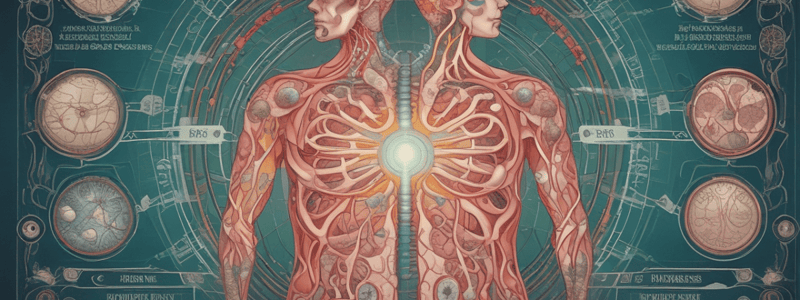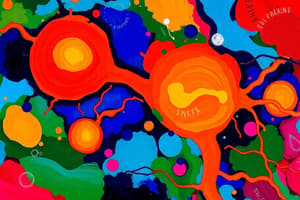Podcast
Questions and Answers
Which enzyme is responsible for the decarboxylation step that results in the formation of norepinephrine?
Which enzyme is responsible for the decarboxylation step that results in the formation of norepinephrine?
- Phenylethanolamine-N-methyltransferase (PNMT)
- Dopamine β-hydroxylase (DBH) (correct)
- Monoamine oxidase (MAO)
- Tyrosine hydroxylase
What cofactor is NOT required for the DBH-catalyzed decarboxylation reaction?
What cofactor is NOT required for the DBH-catalyzed decarboxylation reaction?
- Ascorbate
- NADH (correct)
- Fumarate
- Copper
Where does the N-methylation of norepinephrine to form epinephrine occur?
Where does the N-methylation of norepinephrine to form epinephrine occur?
- In the mitochondrial matrix
- In the nucleus of chromaffin cells
- In the secretion granules of chromaffin cells
- In the cytoplasm of chromaffin cells (correct)
What is required to induce the synthesis of phenylethanolamine-N-methyltransferase (PNMT)?
What is required to induce the synthesis of phenylethanolamine-N-methyltransferase (PNMT)?
What happens to norepinephrine once it is formed in chromaffin cells?
What happens to norepinephrine once it is formed in chromaffin cells?
Why is norepinephrine the main product of extramedullary tissues?
Why is norepinephrine the main product of extramedullary tissues?
Study Notes
Decarboxylation
- Decarboxylation occurs in secretion granules of chromaffin cells.
- It involves the side chain hydroxylation of dopamine, resulting in the formation of norepinephrine.
- The reaction is catalyzed by dopamine β-hydroxylase (DBH) enzyme in the presence of ascorbate, copper, and fumarate as coenzymes.
- This reaction is irreversible.
- Once norepinephrine is formed, it returns to the cytoplasm for further steps.
Side Chain Hydroxylation
- No additional information provided.
N-Methylation
- N-methylation occurs in the cytoplasm of chromaffin cells.
- It involves the N-methylation of norepinephrine, resulting in the formation of epinephrine.
- The reaction is catalyzed by phenylethanolamine-N-methyltransferase (PNMT) enzyme.
- The synthesis of PNMT requires an induction process by high glucocorticoid hormones concentration (100-fold concentration gradient over systemic blood).
- This high glucocorticoid concentration is present in the adrenal medulla, explaining why epinephrine is the main product of adrenal medulla.
- In contrast, norepinephrine is the main product of extramedullary tissues due to the lack of high glucocorticoid concentration.
Storage and Release of Hormones
- After formation, dopamine, norepinephrine, and epinephrine are stored in secretion granules of chromaffin cells.
- They are released on demand.
Studying That Suits You
Use AI to generate personalized quizzes and flashcards to suit your learning preferences.
Description
This quiz covers the process of hormone synthesis, specifically decarboxylation, side chain hydroxylation, and N-methylation in endocrine cells.




